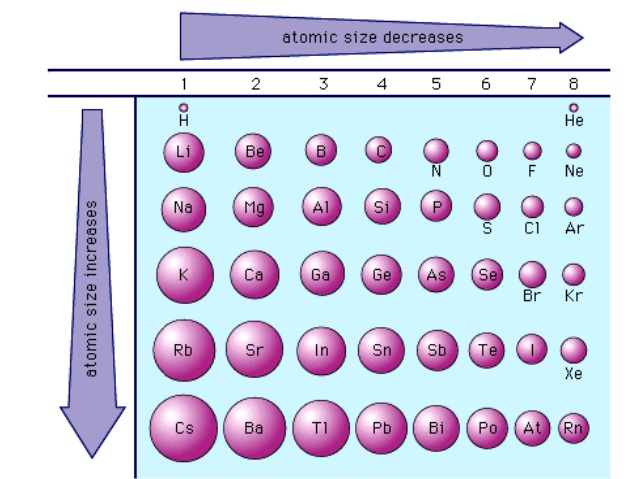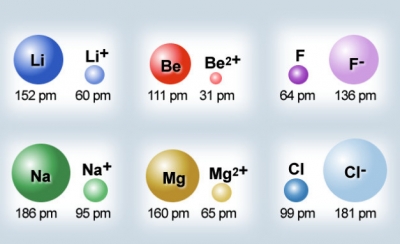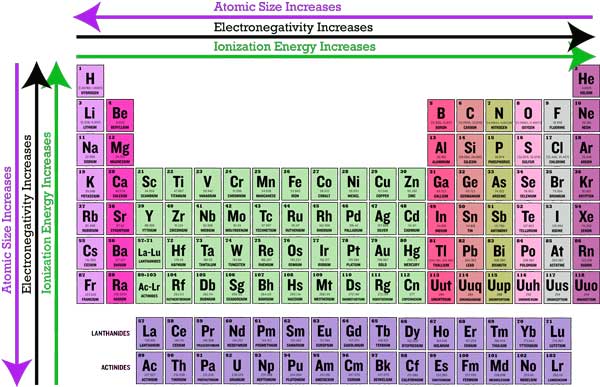Dalia Savy
Jeremy Kiggundu
AP Chemistry 🧪
269 resourcesSee Units
A cool thing about the periodic table is that it is organized to demonstrate different trends and properties of elements. Rather than only understanding the trends, you should be able to explain why they happen.
Atomic Radius
The atomic radius is the distance between an atom's nucleus and its valence electrons.
Across a Period - Smaller
Going from left to right on the periodic table, the atomic radii get smaller. As you go right, the atomic numbers increase. This means that there is a higher nuclear charge which increases the pull the nucleus has on the electrons. The closer the electrons are to the nucleus, the smaller the distance.
This trend can also be explained by the fact that all elements in a period have the same number of shells. For example, both Li and F have 2 shells.
Down a Group - Larger
As you go down a group on the periodic table, the atomic radii increases. This is because the number of occupied shells increases. For example in group 1, Li has 2 occupied shells while Cs has 6 occupied electron shells.

Image Courtesy of Thivyaapriya
Ionic Radius
The ionic radius is the distance between the nucleus of an ion and the valence electrons of that said ion.
➕ Ions < Atoms
- When metals ionize, they lose an electron and become a positive ion. Losing an electron makes the ion decrease in size. There is also less electron-electron repulsion, allowing the remaining valence electrons to be closer to the nucleus.
- Sometimes, metals lose their entire valence shell, significantly decreasing the size.
➖ Ions > Atoms
- When nonmetals ionize, they gain an electron and become a negative ion. Gaining an electron makes the ion increase in size. There is also more electron-electron repulsion.

Image Courtesy of Dublin City Schools
Electronegativity
Electronegativity refers to how strong a nucleus attracts electrons of another atom.
Across a Period - Increases
This is true as atoms closer to noble gases require less electrons to fill their outer shell, thus making them more electronegative as they need less energy to attract other atoms.
Down a Group - Decreases
As you go down a group, the atomic size increases. Therefore, the nucleus of one atom is farther away from the electrons of another atom, and the attraction is weaker.
💡Tip - Fluorine is most electronegative element on the periodic table, with the value of 4.0. Just remember that and this trend should be easy to keep in mind.
Ionization Energy
Ionization energy is the amount of energy needed remove the valence electrons. Since there are multiple valence electrons, there are multiple ionization energies. The first I.E. is the amount required to remove the most loosely held electron and the second I.E. is the amount required to remove the second most loosely held electron.
Across a Period - Increases
Since size decreases, the nucleus and the electrons are more closely attracted to each other. This makes it harder to remove a valence electron and it takes more energy to do so.
Down a Group - Decreases
As you go down a group, the amount of occupied electron shells increases. The valence electrons that are farther away are more loosely attracted to the nucleus. Therefore, it takes less energy to remove them.
Information to Note
- The 2nd I.E. will always be greater than the first since inner electrons are more strongly attracted to the nucleus.
- There are some exceptions to this trend!
- 1st I.E. for group 15 > 1st I.E. for group 16.
Image Courtesy of Quora
- This electron is in an already occupied orbital. The repulsion experienced will lower the required energy to remove the outermost electron, making the 1st I.E. lower than expected for S.
- I.E. of Be>B and Mg>Al
- Quantum Tunneling - The 2p electron in B is easier to remove than a 2s electron in Be. This is because the 2p electron spends more time away from the nucleus while the 2s electron may tunnel towards the nucleus for enough time to make it more difficult to remove.
Valence Electrons
- Using the ionization energies given below, determine the number of valence electrons this element has.
- I1 = 500
- I2 = 1500
- I3 = 7000
- I4 = 9000
When you are given this type of question, just look for the huge jump in ionization energies. This gap occurs because of how much more energy it takes to remove core electrons from an atom.
Therefore, this element has 2 valence electrons!
Electron Affinity
Electron Affinity is the energy change when an electron is added to an atom.
Across a Period - more negative
Down a Group - more positive
The more negative the energy, the more energy is released!
There isn't much you have to memorize here, but Cl has the highest magnitude of electron affinity. F is too small and the electrons are so close together that they would repel, which takes energy.
Overview Image

Image Courtesy of Sciencetute
🎥Watch: AP Chemistry - Periodic Trends
Browse Study Guides By Unit
⚛️Unit 1 – Atomic Structure & Properties
🤓Unit 2 – Molecular & Ionic Bonding
🌀Unit 3 – Intermolecular Forces & Properties
🧪Unit 4 – Chemical Reactions
👟Unit 5 – Kinetics
🔥Unit 6 – Thermodynamics
⚖️Unit 7 – Equilibrium
🍊Unit 8 – Acids & Bases
🔋Unit 9 – Applications of Thermodynamics
✏️Frequently Asked Questions
✍️Free Response Questions
🧐Multiple Choice Questions
📆Big Reviews: Finals & Exam Prep

Fiveable
Resources
© 2023 Fiveable Inc. All rights reserved.